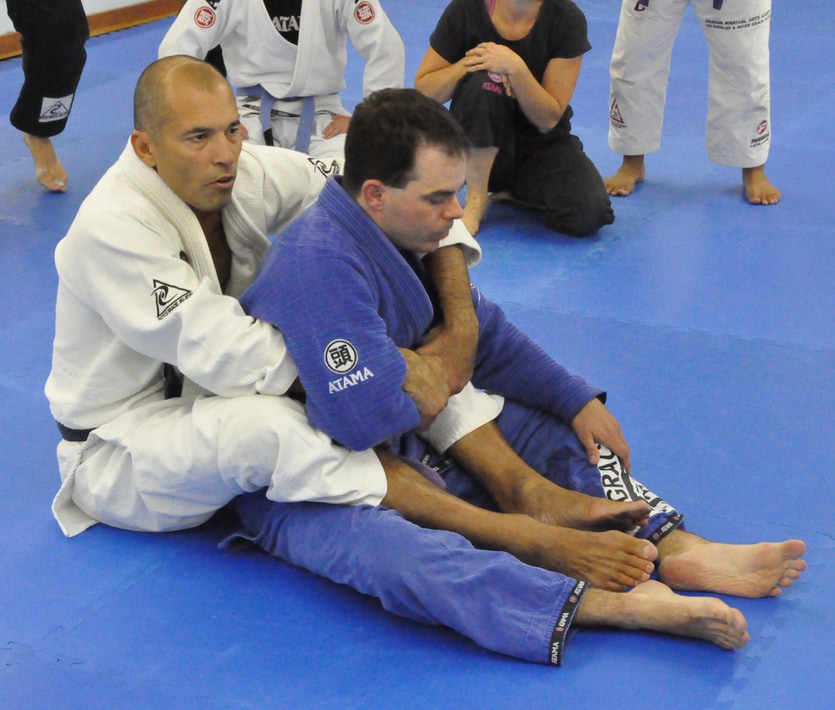Back mount or back control is arguably the best position in BJJ, but it’s not necessarily an easy position for either the top or the bottom player. Understanding what the top and bottom person are trying to do in back mount and what their options are can help you break through such stalemates. In this article you’ll read everything you need to know to be effective in back mount from both top and bottom.
What Is Back mount?
Back mount is a dominant position in Brazilian Jiu Jitsu (BJJ) and other grappling martial arts. It is also commonly referred to as “the back”.
The back mount position is achieved when one combatant gets behind the other and hooks their legs around their waist (known as “taking the back”). From this dominant position, the fighter on top can control and attack their opponent with a variety of submissions, including chokes and arm locks.
The back mount position is considered one of the most advantageous in BJJ and grappling martial arts because it severely limits the options of the person on the bottom. When someone has your back, you are effectively pinned and at a severe disadvantage.

Back Mount vs Back Control
Back mount and back control are often used interchangeably, but there is a subtle difference between the two.
Back mount refers to the position itself, i.e. when one fighter has taken the back of another with a seatbelt and two hooks or a body triangle. Back control, on the other hand, refers to the control that the fighter on top has over their opponent.
So, back control can be achieved to various degrees from a number of different positions, not just back mount. For example, when you have a tight seatbelt in the turtle position but no hooks, you have a substantial amount of back control, but you don’t have full back mount.
How To Attack Submissions from Back mount
If you find yourself in back mount, the first thing you need to do is sink in your hooks. This will help you control your opponent and prevent them from escaping.
Once you have sunk in your hooks, you need to establish a good grip. This can be done by grabbing the back of your opponent’s Gi or belt, or by controlling their wrists.
From here, you can begin working on submissions. There are a variety of submissions that can be done from back mount, but the most common are rear-naked chokes and arm locks.
Rear-naked choke: This is a choke that is applied by controlling the back of your opponent’s head and squeezing their carotid arteries.
Arm lock: This is a joint lock that is applied by controlling your opponent’s arm and hyperextending their elbow.
Once you have secured a submission, you need to maintain control of your opponent until they tap out or the referee stops the match.
How to Escape Back mount
How to escape back mount depends on the details of your opponent’s back control. But typically there are a number of steps you should follow to escape back mount.
- If you find yourself in back mount, the first thing you need to do is prevent your opponent from sinking in their hooks and connecting their seatbelt. This will make it much more difficult for them to control you and make it easier for you to escape.
- When you free yourself of at least one of the hooks, you can start to put your hips on the mat and start turning them towards your opponent.
- When you free yourself of the seatbelt, you can start to put your shoulders on the mat and start turning towards your opponent.
- You always conclude the back escape when you bring your elbow on the floor in between you and your opponent. This is your frame that they can’t get back behind again to retake your back.
How Do You Get Back Mount in BJJ?
There are a variety of ways to get back mount in BJJ, but the most common are to take the back from the guard, to take the back from standing, or to sweep your opponent into back mount.
Taking the back from the guard: This is done by establishing a grip on your opponent’s Gi or belt and then using your legs to take their back, most commonly from closed guard, with the underhook sweep from half guard, or from open guards such as de la Riva and reverse de la Riva.
Taking the back from top: This is done when your opponent turns away from you in side control or turns to his belly in mount. The chair sit is the most common way to finish this type of back take.
Taking the back from standing: This is done with arm drags, Russian ties, spin arounds from a stuffed takedown and similar attacks. Once you get to the back you can either jump on the back and sink your hooks in while still standing or drag your opponent down to the floor first.
Once you have taken your opponent’s back, you need to sink in your hooks and establish a good grip. From here, you can begin working on submissions.
How Do You Hold Back Mount in BJJ?
There are multiple ways to hold back mount in BJJ, that differ in leg position. The most common ways are with hooks or with the body triangle.
Holding back mount with hooks: This is done by sinking your hooks into your opponent’s inside thighs. This controls their hips from rotating either way and still lets you move your legs freely.
Holding back mount with the body triangle: This is done by putting your legs in a triangle around your opponent’s waist. This controls the hips very tightly but it also limits your own mobility.
Who Has The Best Back Mount in BJJ?
There is no one definitive answer to this question. While there are some grapplers who are considered to be particularly skilled at back mount, the position itself is so advantageous that even a relatively inexperienced fighter can be successful from this position.
That said, some of the most successful back mount practitioners in BJJ include Marcelo Garcia, Roger Gracie, and Gordon Ryan.
What’s The Best Back Mount Instructional?
There are a number of excellent back mount instructional videos and DVDs available. Some of the best include:
- The MG Back Attack System 2.0 by Marcelo Garcia
- Back Attacks Enter The System by John Danaher
- Maintaining Back Control by Andrew Wiltse
- The Maia Backpack System: Controlling The Back by Demian Maia
- Systematically Attacking The Back by Gordon Ryan
- Precision Back Takes by Lucas Lepri
